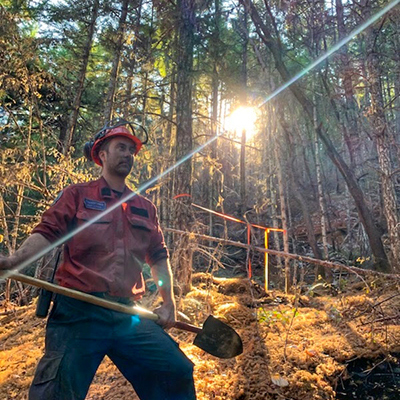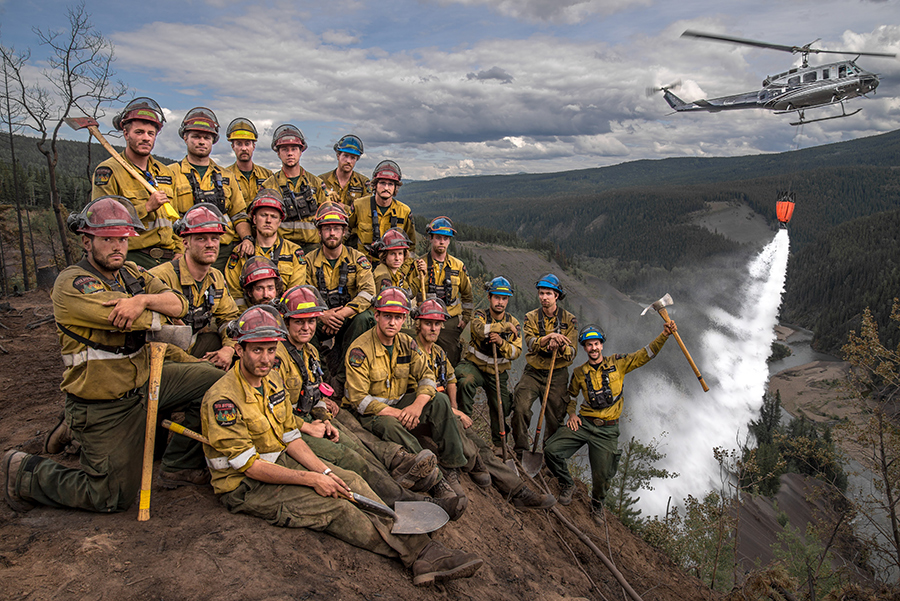Episode features Forest Technology grad and author Harold Larson
 There’s a certain mystique about wildfires. We see the footage on TV of thick plumes of smoke and helicopters dousing hotspots with buckets of water. And everyone in Alberta remembers the images from Fort McMurray in 2016 – the inferno, the devastation and the immense challenge of keeping the fire in check.
There’s a certain mystique about wildfires. We see the footage on TV of thick plumes of smoke and helicopters dousing hotspots with buckets of water. And everyone in Alberta remembers the images from Fort McMurray in 2016 – the inferno, the devastation and the immense challenge of keeping the fire in check.
“It’s a very dynamic environment that changes every day, so you never know what you're going to see.”
It’s harder to comprehend what life is like for those on the front lines, putting out the fire. What it really means for the men and women who spend weeks at a time in far-away locations, working under intensely stressful conditions.
In this episode of Career Essentials, firefighter Harold Larson (Forest Technology ’13) shares lessons about leadership and managing stress that he learned during 20 years of fighting some of the country’s biggest and hottest wildfires. He also provides a sneak peek about his second book about leading wildfire fighting crews.
Techlifetoday
For most of us, we see images of wildfires on TV. Or, in a city like Edmonton in the summer we see the haze wildfires create sometimes from hundreds or thousands of kilometres away. What's it actually like to be working on a wildfire fighting crew? To be right there, facing this enormous and potentially life-threatening situation?
Harold Larson
It’s a pretty exciting job. It’s a very dynamic environment that changes every day, so you never know what you're going to see. Every part of the forest is different. When you get called to a fire, in the initial stages, your main tactic is to stop the fire from growing, not necessarily put it out. So you want to put out the perimeter. Once the fire is contained, you spend your time making sure that the fire’s out. So you're going over every foot of the forest making sure that there's nothing that's going to reignite that could happen sometimes even the next year. So it's a lot of work. Sometimes you're working 16 hours a day up to 24 days in a row with four days off in between. So it takes a grind on you, for sure.
You've been a wildland firefighter your entire adult life. And in fact, you started fighting fires when you were still in high school as a 16-year-old. What was it about wildland firefighting that appealed to you? Or are you just kind of an adventurer at heart?
I lived outside of Kamloops, B.C., so I was actually working on the farms around there in the summer. And farming was all right, but wildland firefighting seemed a bit more exciting. Me and a buddy applied and we ended up getting on a crew in the summer break between Grade 11 and 12. We got to go to the [United] States for like 45 days to fight fires and got kind of hooked on it. And 20 years later, I still did it.
You also fought fires overseas, including the Black Saturday Bushfires in the state of Victoria in Australia, which ended up being one of the country’s deadliest wildfires, claiming 173 lives. You were 25 at the time. What was that experience like?
I just happened to be there when there's an eight-year drought going on and there's record-breaking temperatures. And a few thousand fires started in one day and kind of overwhelmed this state. The town that I was in, 34 people died, so it was a pretty scary time. There's a lot of people that died because of those fires. A lot of changes have been made since then, but that was a pretty gruelling time for myself as a bit younger. I hadn’t really adopted a lot of the coping skills that I do now, but I'm glad that there's something that I got to experience and help out on.
“I just happened to be there when there's an eight-year drought going on and there's record-breaking temperatures.”
Not long after graduating from NAIT, you decided to lead a 20-person unit crew in the Peace River area. From what I understand, that meant living and training together for eight months straight and getting deployed to some of the largest, most intense fires. Is that as stressful a job as it sounds?
It's probably more stressful than it sounds. When I first started, I'd never been on a crew like that before. Getting thrown into that, it was a challenge. I'd been leading crews for a while, but I was fortunate enough to have other leaders – sub-leaders on my crew – that were able to help me out. And we were able to come together as a team.
The job doesn't stop when the clock stops; you're still living at base camp with these people and you're still making sure that they're being taken care of. Usually everyone on the crew is between 20 and 30, so a lot of young men and women that are dealing with other issues besides fighting a fire and being away from home.
Also figuring out how to use 20 people properly on a fire is a big learning curve. Being a good supervisor, a good leader, just like being a good firefighter, doesn't happen overnight. It takes time and you need to learn from your mistakes and get those experiences to help you become the better leader that you want to be.
 You mentioned that learning how to lead a group takes time. How did you learn to build rapport with your crew and be the leader that everyone needed?
You mentioned that learning how to lead a group takes time. How did you learn to build rapport with your crew and be the leader that everyone needed?
It comes from building trust. So not being that leader, that supervisor that just tells people what to do. You actually do it with them. I'm not going to tell somebody to do something that I’m not willing to do myself. So you're doing the hard yards with them and working harder than they are, being physically fit, and showing them that you have that passion. And it gets kind of contagious.
“And as long as you're leading by example, it seems to go a long way.”
When you start going through different fires and different emergency scenarios with each other, you build a trust and camaraderie. That's pretty rare [and something] that I haven't really seen in any other types of jobs that I've had. It just gets stronger and stronger. And as long as you're leading by example, it seems to go a long way.
In most workplaces, there's bound to be a little bit of friction and conflict at times between co-workers. I can only imagine what it's like with a group of 20 individuals who are in such tight quarters. Did things ever get to the point where people would start to grate on each other's nerves? How did you resolve potential conflict?
From the first day to the last day, there's always something. There's 20 different personalities and not everybody can be friends and that's all right. But as long as you learn to respect and work well together, that that goes a long way. Some people are just very different and some people just grind each other's gears in a way that I can't really understand. When you're embracing each other's strengths and helping build each other up, when you do that as a whole, the amount of work that could be done is pretty amazing.
“There's 20 different personalities and not everybody can be friends.”
That dynamic and your experiences as a crew leader, that’s the subject of your second book, correct?
Yes. It's almost finished. I wrote it about my first two seasons as a unit crew leader in Peace River. It was a pretty rare time in my life – and probably pretty rare time in a lot of those people's lives. I thought I was just a good story to share. The fires, the emergency responses that we did [were] maybe the most exciting things to write about, but the dynamic that we had together and the camaraderie and the friendships that we built and some of the stories are pretty entertaining.
In 2020, you moved to the West Coast where you’re now a firefighter for an urban department. As you’ve adjusted to working in a city and faced the realities of life during the pandemic, are there any lessons from your wildfire days that help you cope with stress?
Stress is a part of your life and there's different types of stress. When I'm getting fatigued or I'm super stressed out, I can get a little bit of tunnel vision and I can get focused on something. But until you're learning to recognize those different aspects of stress and how your body reacts to it, man, it's hard to deal with.
With wildfire, especially with the crews that I was on, it's more about the long game. So it's dealing with long-term stress. And that’s definitely something I've seen with the pandemic going on is a bit of COVID fatigue. It’s been eight or nine months and people are kind of over it, but just because you're over it doesn't mean it's over. And that’s the same with wildfire. You have to make sure that you're doing those things every day – getting proper sleep and knowing how to manage your fatigue, proper nutrition. It helps to have a good support network of friends and family and those people to lean on when you need it. It goes a long way.